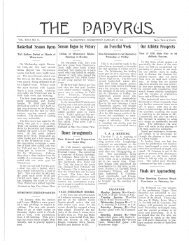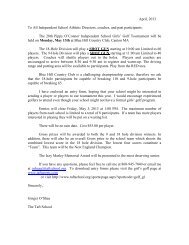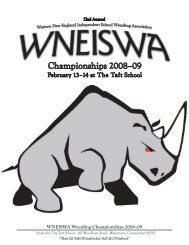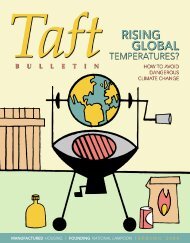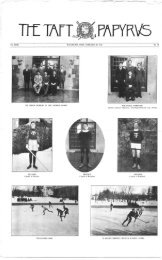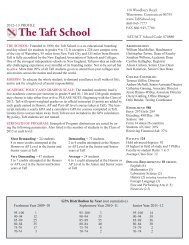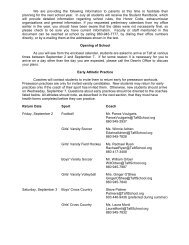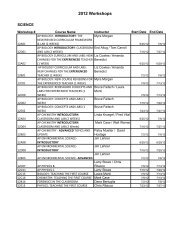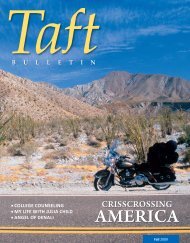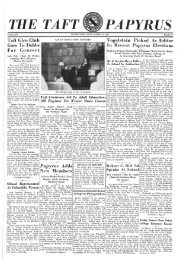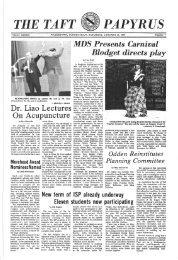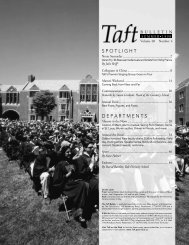Create successful ePaper yourself
Turn your PDF publications into a flip-book with our unique Google optimized e-Paper software.
B U L L E T I NFall 2008Volume 79 Number 1Bulletin StaffDirector of DevelopmentChris LathamEditorJulie ReiffAlumni NotesLinda BeyusDesignGood Design, LLCgooddesignusa.comProofreaderNina MaynardMail letters to:Julie Reiff, Editor<strong>Taft</strong> Bulletin<strong>The</strong> <strong>Taft</strong> <strong>School</strong>Watertown, CT 06795-2100 U.S.A.ReiffJ@<strong>Taft</strong><strong>School</strong>.orgSend alumni news to:Linda BeyusAlumni Office<strong>The</strong> <strong>Taft</strong> <strong>School</strong>Watertown, CT 06795-2100 U.S.A.<strong>Taft</strong>Bulletin@<strong>Taft</strong><strong>School</strong>.orgDeadlines for Alumni Notes:Winter–November 15Spring–February 15Summer–May 15Fall–August 30Send address corrections to:Sally MembrinoAlumni Records<strong>The</strong> <strong>Taft</strong> <strong>School</strong>Watertown, CT 06795-2100 U.S.A.<strong>Taft</strong>Rhino@<strong>Taft</strong><strong>School</strong>.org1.860.945.7777<strong>Taft</strong>Alumni.com<strong>The</strong> <strong>Taft</strong> Bulletin (ISSN 0148-0855)is published quarterly, in February,May, August, and November, by <strong>The</strong><strong>Taft</strong> <strong>School</strong>, 110 Woodbury Road,Watertown, CT 06795-2100, and isdistributed free of charge to alumni,parents, grandparents and friendsof the school. All rights reserved.1628This magazine is printed onrecycled paper.7
FEATURESIn the Footsteps of Joyce:A Literary Tour of Ireland.........................................1 6By Sharon Phelan and Barbara Romaine ’09, photography by JohnLombard ’09World Scholars.........................................................2 2Seven students from around the corner and across the globe are makingthe most of a <strong>Taft</strong> education thanks to the Davis Scholars ProgramBy Rick LansdaleLicense to Laugh......................................................2 8It’s all funny business for the president of King Features Syndicate,Rocky Shepard ’69, who is responsible for marketing and licensingcomic strips and their characters around the world.By Bill Slocum, Greenwich MagazineDEPARTMENTSLetters...................................................................... 2Alumni Spotlight...................................................... 3Around the Pond..................................................... 7Alumni Notes...........................................................3 5Milestones................................................................7 2From the Archives....................................................7 6On the Cover: John Lombard ’09 captured this Dublin street sceneat dusk on his visit there in June. (For more of his work, see page 16.)<strong>Taft</strong> on the WebFind a friend’s addressor look up back issuesof the Bulletin at<strong>Taft</strong>Alumni.comWhat happened atthis afternoon’sgame? Visit<strong>Taft</strong>Sports.comFor more campusnews and events,including admissionsinformation,visit <strong>Taft</strong><strong>School</strong>.orgDon’t forget youcan shop online at<strong>Taft</strong>Store.com800.995.8238or 860.945.7736j Mist still hangs on the pond asclassics teacher Dick Cobb heads toclass one morning. Pe t e r Fr e w ’75
Wave-Powered WondersInterested in fighting global warmingby reducing the amount of CO 2inthe atmosphere, reducing hurricanestrength, protecting coral reefs, and enhancingfish populations by upwellingnutrients to enhance phytoplankton?All it takes, perhaps, are a few wavepoweredocean pumps.In May, the Climate Foundationand Atmocean participated in an oceantest of three pumps in the Pacific about60 nautical miles north of Hawaii. Wavedrivenocean pumps can be deployed ina linear array to upwell cooler water intothe mixed layer and reduce peak temperaturesof surface waters. Colder watercontains more life, and so in principlecan absorb more carbon. <strong>The</strong> test is featuredon the Discovery Channel ProjectEarth episode “Hungry Oceans.”“<strong>The</strong> problem we would be mostconcerned about would be acidification,”Atmocean CEO Phil Kithil ’61 told BBCNews. “We’re bringing up higher levelsof CO 2along with the nutrients, so it allhas to be analyzed as to the net carbonbalance and the net carbon flux.”Atmocean is developing its patentspendingwave-driven ocean upwellingsystem to cool the upper ocean andenhance natural biological processes toabsorb CO 2. When widely deployedacross critical ocean regions, the technologymay also mitigate coral reefbleaching and help reduce hurricaneintensity driven by rising ocean temperatures.Upwelling is the naturallyoccurring mixing of deep, cold, nutrient-richocean into the upper sunlitocean that is critical to growth of mostmarine species, so it may enhance oceanfisheries as well.“We believe our wave-driven upwellingtechnology can play a criticalrole in mitigating these deleterious effectsof CO 2-induced warming, in theyears and decades ahead,” adds Phil. Formore information visit atmocean.com.. Phil Kithil ’61explains how his wavedrivenpumps mighthelp change climate.<strong>Taft</strong> Bulletin Fall 2008 3
m Peter Berg ’80, who starred in thetelevision series Chicago Hope anddirected the 2004 film Friday NightLights, takes on the cult classic Dune.Co u r t e s y o f Peter BergSuperheroto Sci-FiIn director Peter Berg’s summerblockbuster, Hancock, Will Smithplays a superhero “who swills bourbon,hates his job and…looksunnervingly like Berg. ProducerAkiva Goldsman told the New YorkTimes that, “Smith, on meetingBerg in one of his work-worn states,said: ‘Oh. Oh. He is Hancock.’”Always looking for more adventure,Berg is now directing hisattention to a new version of thesci-fi classic Dune for ParamountPictures. <strong>The</strong> award-winning andhugely popular science fiction novelpublished in 1965 has alreadybeen made into a film as well as atelevision series, but Berg told theHollywood Reporter, “I read thebook and really liked it. What Inever saw in Lynch’s film was a reallystrong adventure story. <strong>The</strong>re’sa much more muscular time to behad there.”Peter is also working on thescript for Universal Pictures’ LoneSurvivor, about a Navy Seal wholed a team into Afghanistan on amission to kill a Taliban leader butwas the only one to survive.Even though Friday NightLights may be over (Berg directedthe film and produced the televisionseries), he can’t quite get footballout of his blood and now makestime to coach his son’s team.Global Health<strong>The</strong> road is unpaved and few cars orbuses pass through the Peruvian neighborhoodwhere the Centro de Salud deSanta Elena is located, but the healthcenter is the first place patients from thesurrounding rural areas come to, oftenwith medical emergencies such as heartattacks and complicated deliveries.Neena Qasba ’02, a medical studentat UConn <strong>School</strong> of Medicine, hascome to know the center well. While anundergraduate at Johns Hopkins, shespent six weeks in the provincial capitalof Ayacucho, as a global studies andLatin American Studies Research Awardfellow, researching the formal and traditionalmedical systems in rural Peru.“I first went as a volunteer and thenI got really attached to the place,” saysNeena. “<strong>The</strong> doctors are very dedicatedand they have sacrificed the limelightand high-paying salaries of the city towork in a government run health centerin a rural and poor part of Peru. <strong>The</strong>ircommitment to patients inspired me.”Ayacucho is nestled in a valley inthe southeast corner of the PeruvianAndes. It was a strategically importantcity during the Incan Empire, locatedbetween Cuzco and Lima. She becamemesmerized by its scenery, immersed inits cultural history, attached to its peopleand deeply troubled by its povertyand underdevelopment.Located in the poorest area ofHuamanga (population 20,000), thehealth center is 20 minutes from theregional hospital. While there, Neenashadows doctors, attends births, and assistsin health fairs.“Many mothers at the health centertold me that it was their first deliveryat a medical establishment because it istradition to give birth at home with thevillage partera (midwife) surrounded byfamily and friends,” adds Neena. <strong>The</strong>setraditions are now being considered byhealth providers and policymakers topromote culturally sensitive birthingm Her work in Peru helped inspire NeenaQasba ’02 to study medicine.practices at health centers, she explains.Maternal deaths occur all too frequentlyin this area while women still choose togive birth at home.“<strong>The</strong> doctors and patients ofAyacucho welcomed me with openarms and taught me about their beautifulland,” she says. “As a future physicianand as a fellow human being, I have anobligation to help and fulfill the medicalneeds of this community. <strong>The</strong> wordsof the <strong>Taft</strong> motto have always resonatedwithin me—to be of service to others.We hope our work is not simply aboutcharity, but about improving healthcareinfrastructure and developing sustainableresources to deliver medical care forfuture generations.”With a team of UConn studentsand former Hopkins classmates, Neenais working with the Peruvian AmericanMedical Society to bring medical equipmentand supplies to the center. <strong>The</strong>y havebrought the first electrocardiogram andare fundraising to provide an ambulance,defibrillator and ultrasound machine.“Ayacucho was my initial inspirationto pursue a career in medicine,”Neena says, “but going forward I seeglobal health as an integral part of mypersonal and professional life.”For more information, contactNeena at nqasba@student.uchc.edu.4 <strong>Taft</strong> Bulletin Fall 2008
Golfing BuddiesMore than 100 friends and familyattended a golf benefit at the DukeUniversity golf course on August 11,nearly a year after Phil Ficks ’68 was injuredin a bicycle accident.Phil was hit by a truck while trainingfor a triathlon and remains partiallyparalyzed. “Through tremendous courageand tenacity, he remains true to avery strenuous therapy program as hisprognosis improves ever so slowly,” explainsclassmate Randy Abood. “Wewant to raise money for therapy that isnot otherwise covered by insurance.”To find out how you might help,please contact Randy Abood (see 1968Notes on page 51 for more information).c Classmates Rick Palamar, Jack Smith,Ken Abramowitz and Randy Abood withPhil Ficks at the August golf benefit onPhil’s behalf.EDGEWISE: New Play by Eliza Clark ’03Playwright Eliza Clark’s gritty, comedicthriller, Edgewise, opened at New York’sCherry Lane <strong>The</strong>atre in July.<strong>The</strong> story involves three suburbanteens, working at a New Jersey burgerjoint, who find their safety compromisedand allegiances tested when abomb raid blows a hole in their restaurant,and a bloodied stranger stumblesin the door. Set in the midst of WorldWar III, where terror reigns and internationalalliances hang in the balance,these teenagers deal with the unknownthe only way they know how—by tyingit up. Edgewise explores the trialsof American adolescence in a post-9/11world. For more information, visitwww.edgewise-theplay.com.Eliza’s work has appeared at theProvincetown Playhouse, at YaleUniversity and in the New YorkInternational Fringe Festival. Her plays,<strong>The</strong> Metaphysics of Breakfast (2005),Hiccup (2006) and Puppy (2007) werefeatured in the Yale Playwrights Festivalperformed at Yale Repertory <strong>The</strong>atrethree years in a row.She is a co-creator, writer andperformer for the internet sitcom“Inconvenient Molly.”b Three suburban teenagers deal with theunknown the only way they know how in anew play by Eliza Clark ’03.<strong>Taft</strong> Bulletin Fall 2008 5
In PrintWRITERS IN PARIS: Literary Lives in the City of LightDavid Burke ’54Counterpoint, 2008Literary detective David Burke exploresthe most creative quartiers ofthe City of Light, the Latin Quarterand the Marais, raffish Montmartre,“Lost Generation” Montparnasse andothers. He tracks down the haunts ofdozens of the world’s finest and mostcolorful writers in this unique look atliterature’s greatest city. From nativeParisians such as Molière and MarcelProust to expatriates like Henry Millerand Samuel Beckett, Writers in Parisfollows their artistic struggles and miraculousbreakthroughs, along withthe splendors and miseries of their invariablycomplicated personal lives.With maps, descriptions and morethan one hundred photographs, Writersin Paris also pinpoints key places in thelives of fictional characters, includingGargantua’s ribald visit to the towers ofNotre Dame and Vladimir and Estragon’swobbly first step onto the stage of anobscure little Left Bank theater.Burke is a writer and documentaryfilmmaker who went to Paris in1986 for what he thought would be astay of one year, but turned into morethan twenty. He now divides his timebetween Paris and the United States.<strong>The</strong> Little Book: A NovelSelden Edwards, former facultyPenguin, 2008<strong>The</strong> Little Book is the extraordinary tale ofWheeler Burden, California-exiled heirof the famous Boston banking Burdens,philosopher, student of history, legend’sson, rock idol, writer, lover of women,recluse, half-Jew, and Harvard baseballhero. In 1988 he is forty-seven, livingin San Francisco. Suddenly he is—stillhis modern self—wandering in a cityand time he knows mysteriously well:fin de siècle Vienna. It is 1897, preciselyninety-one years before his last memoryand a half-century before his birth.“This novel ends up a sweet,wistful elegy to the fantastic promiseand failed hopes of the 20th century,”writes Publishers Weekly.Selden Edwards began writing <strong>The</strong>Little Book as a young English teacher in1974, and continued to layer and refinethe manuscript until its completion in2007. It is his first novel. He spent his careeras headmaster at several independentschools across the country, and for over 40years has been secretary of his Princetonclass, where he also played basketball. Helives in Santa Barbara, California.Embracing the Edge: Stories of Tenacity and Personal PowerNeil Peterson ’61Edge Foundation, 2008Self-proclaimed “serial entrepreneur”Neil Peterson founded five companiesduring his 40-plus-year career, mostnotably Flexcar, the award-winningcar-sharing company that recentlymerged with Zipcar. Peterson’s resumeis an impressive list in both the publicand private sectors. Numerousawards, including Time magazine’s“100 Newsmakers of Tomorrow” inSeattle, attest to his success.But over the years, Petersonsays, “no one suspected I sufferedfrom Attention-Deficit/HyperactivityDisorder until my two children werediagnosed with ADD and ADHD intheir mid teens.” Embracing the Edge,Peterson’s newly published collectionof personal inspirational stories, recountshow he overcame physical andlearning disabilities, as well as life’snormal disappointments, to becomea successful entrepreneur, corporateexecutive and public servant.Having seen the benefits of personalcoaching in his own life andthose of his children as an effectiveintervention strategy and an importantpart of a multi-prong ADHDtreatment approach, Peterson foundedthe Edge Foundation, an organizationcommitted to providing professionalcoaches for students with ADHD tohelp them realize their potential andtheir passion, and to become tomorrow’sleaders and innovators.No Love LostKate Schutt ’93Artist Share, 2008You could call Kate Schutt a musical triathlete.She is a guitarist, producer andsinger/songwriter of rare skill and originality.<strong>The</strong> sports analogy is fitting, given thather prowess as an ice hockey and lacrosseplayer helped the Pennsylvania-born andbred former head monitor gain access toHarvard. Her other passion, music, thentook over. After a rigorous education atBerklee College of Music, Kate becametotally committed to music.“Kate Schutt’s debut album, NoLove Lost, has many delightful features,”JazzReview.com writes. “<strong>The</strong>se songsare more than coffeehouse tunes. <strong>The</strong>classic jazz buffers and fluency of bluesin her folk music makes this an albumthat you can read a book to, sip a drinkwith, or enable you to be private withthose thoughts that you needed tomake time for but have neglected in thecourse of the day. <strong>The</strong> album is comfortablefor entertaining any company.”All About Jazz described herwork as “old school gypsy jazz aesthetics”and praised Schutt’s “wise,original words, persuasive melodiesand economic arrangements.”Her latest project, TelephoneGame, is available at kateschutt.com,as is information on her touring schedule,which includes upcoming events inPhiladelphia and Toronto.6 <strong>Taft</strong> Bulletin Fall 2008
j ChaplainBob Ganungdisplaysthe school’snewlyacquiredQur’an.Yee-Fu n YinFor the latest newson campus events,please visit<strong>Taft</strong><strong>School</strong>.org.Around the pondby Sam RouthierKeeping the FaithAs <strong>Taft</strong>’s student body, faculty and curriculumbecome as internationally andculturally diverse as ever, Chaplain BobGanung has looked to bring studies ofworld religion into the consciousness ofthe community. In that vein, and withthe help of a series of donors, the schoolhas put together a collection of originaltexts of Holy Scripture. Most recently,the school has acquired an originalQur’an from the late 19th-century,handwritten and illustrated by calligrapherMohammad Wasfy. <strong>The</strong> Qur’anjoins a collection of sacred texts thatalready includes a 19th-century Torahand a 1616 King James Bible.<strong>The</strong> Holy Qur’an arrived at <strong>Taft</strong>with the help of U.S. Ambassador toSaudi Arabia Ford Fraker, the school’s2008 commencement speaker and parentof Antonia ’04, Jonathan ’06, andCharlie ’08. His current post connectedhim with Jeddah businessman SheikhKhalid Alireza, and when AmbassadorFraker and Sheikh Khalid discussed<strong>Taft</strong>’s initiative to acquire sacred textsSheikh Khalid enthusiastically offeredto donate the Qur’an.“<strong>The</strong> Qur’an will, I trust, be a guidinglight to make people aware of thetremendous similarities between theAbrahamaic faiths, which I and myfamily hope will lead to better understandingand tolerance in this world,”Alireza wrote to <strong>Taft</strong> headmaster WillyMacMullen ’78.Ambassador Fraker commented,“<strong>The</strong>re are few things more importantthan understanding what the great religionsof the world have in common, sothat they can be a source of world unityand peace. This gift is framed by the interfaithdialogue initiative launched by KingAbdullah of Saudi Arabia at his MadridConference last July, which saw representativesfrom all the world’s religions meetto discuss the commonalities inherent intheir faiths. This gift to <strong>Taft</strong> <strong>School</strong> endorsesand reinforces those efforts.”Currently, the Qur’an is displayedin the entrance to the <strong>Taft</strong> library, andthe chaplain hopes to put together a displayof all three sacred texts soon.“<strong>The</strong> books are imbued with spiritualenergy,” Ganung said, “and willcompel the community to think criticallyabout the role of religion in theworld today.”Plenty of other activity is going on in<strong>Taft</strong>’s spiritual department. On campus,Ganung has been working with the JewishStudent Organization and Christian groupFOCUS to help students discuss religionin a reflective manner. He is interested instarting a Buddhist meditation programin the evenings and also in gathering representativesfrom all world religions at <strong>Taft</strong>to celebrate the common ground betweendiverse traditions.Ganung, who succeeded MichaelSpencer last year, hopes to use his role aschaplain “to draw people into the studyof religion and how these great wisdomtraditions have shaped our culture andcontinue to have an impact.”<strong>Taft</strong> Bulletin Fall 2008 7
Big Red Graduates Go GreenIt has long been a tradition at <strong>Taft</strong> for relative invisibility from the ground.each graduating class to make a class “We chose Pioneer Valley in partgift, something to commemorate their because of the educational componentof their system,” said Director oftime at <strong>Taft</strong> and also to remember themby. Past gifts have included such items Facilities Jim Shepard. Students canas benches or trees, but recent graduates actually monitor the impact these solarused their class gift to demonstrate their panels have.leadership in the 21st century.“We’ve been talking about installing[solar panels] for a long time,” said<strong>The</strong> classes of ’07 and ’08, withhelp from the administration and Headmaster Willy MacMullen, “and it’sthe Connecticut Clean Energy Fund, not surprising to me that the impetushave donated a 12,000-kilowatt solar came from the students.”panel array.Students are excited too. This giftIn October, a New Britain-based “shows that there is real concern in thecompany, Pioneer Valley Photovoltaics, student community for the environment,”began installing the system above the senior Nick Tyson said. “It’s a more visiblesquash courts in Cruikshank Athletic change than anything previously.”Center, an area chosen to provide maximumsun exposure. An added benefit entire electricity use of the gym com-While the panels won’t offset theof installing the panels on top of the plex, a significant quantity consideringsquash courts will be, in fact, their the two ice rinks and two field houses,the array is, according to Shepard, “onan appreciable scale.”A 2001 Department of Energy studyfound that an average 2,000-square-foothousehold used 10,656 kilowatt hoursof electricity per year, or almost 2,000fewer kilowatts than <strong>Taft</strong>’s solar panelswill produce.<strong>The</strong> solar panels are only part of<strong>Taft</strong>’s broader efforts to become a greenercampus. New students were greeted thisyear with “goodie bags,” reusable canvasbags with water bottles, compact fluorescentbulbs and important informationabout energy use. Over the summer,one of three oil burners at the steamplant was replaced with a more efficientnatural gas burner, and the facilities officecontinues to replace old windowswith newer better-insulated ones.—Wells Andres ’09Mark W. Potter ’48 gallerySeptember 9 through 20Work by <strong>Taft</strong> StudentsSeptember 26 through October 24Robert EshooFantasy WorldAndrew R. Heminway ’47Memorial Art Fund ExhibitionOpening reception Friday, September 26October 30 through November 22Caitlin Fitzgerald ’90Photographs 1998–2008Opening reception Thursday, October 30December 2 through 17<strong>Taft</strong> Student ShowOpening reception Friday, December 5January 9 through February 6Dawn ClementsWorks on PaperRockwell Visiting ArtistOpening reception Friday, January 9February 13 through March 7Work by <strong>Taft</strong> StudentsOpening reception Friday, February 13April 3 though April 24Yee-Fun YinDaily BreadOpening reception Friday, April 3April 30 through May 30Amy Wynne Derry ’84 and Gail WynneClay and PaintOpening reception Thursday, April 308 <strong>Taft</strong> Bulletin Fall 2008
j With the lower dining hall removed, there are views of HDT not seen in 50 years. Ju l i e Re i f fHardhat HeadlinesEditor’s note: Following up on the summer Bulletin’s cover story about the 53,000-square-foot dining hall addition and HDT renovation,we thought readers would like to follow the progress of the construction. <strong>The</strong>refore, we bring you “Hardhat Headlines,” a report onongoing changes on campus.Construction firm O&G began theirdemolition of the lower dining hallin June. In the four months since, theproject has gone largely to plan, and hasworked hard to minimize its footprint,both aesthetically and logistically, onthe <strong>Taft</strong> community.This past summer, the builders hada three-fold focus of taking down the oldlower dining hall, maintaining all utilitiesthat went through that zone so thatthe rest of the school could function, andbeginning the renovation of Mac House.As a result, enrollment in both <strong>Taft</strong>’s summerschool and in the Teacher EducationCenter decreased by about 25 percent.“Steve McCabe, director of theSummer <strong>School</strong>, David Hostage, whoruns T.E.C., and I all agreed that weneeded to maintain the quality of thosesummer experiences,” said BusinessManager Gil Thornfeldt. “As a result,the numbers had to decrease.”All parties agreed that the programsran smoothly, and that the benefit froma construction perspective is immeasurable.<strong>The</strong> dining hall project got off to agreat start, utilities to the rest of the campuswere preserved, and in Mac House,there is a new heating system, 3.2 milesof piping and all formerly exposed wiringand pipes have been covered. Thornfeldtsaid that the summer work was “painstaking,”but ultimately worthwhile.As the school year has begun, moston campus agree that the constructionfootprint has been relatively small comparedto what they had expected. Inorder to feed the campus, we have startedusing two dining halls, one in theupper dining hall in the HDT buildingand a temporary one in the studentunion and Jigger Shop area.While the weather allowed, the JigPatio had tables and umbrellas for beautifulpond-side dining. Some studentsfelt initially inconvenienced by notknowing where their friends would beeating, most adjusted quite well.“<strong>The</strong> success of the renovationand the minimal footprint on campusare testaments to our whole crew: faculty,staff, the construction workers andstudents,” Thornfeldt said. “I’m alsothankful that alumni are so supportive,loyal and generous, as it is their passionfor the school that continues to movethis project forward.”For recent images of the constructionprogress, please visit <strong>Taft</strong><strong>School</strong>.org.<strong>Taft</strong> Bulletin Fall 2008 9
Around the pondLive From New YorkManhattan—After a chorus of welcomes,greetings and introductions,Megumi Sato, the woman who unifiesJapan and New York via a culturalbridge of music, recent trends, and politicalevents, and our host for the day,cheerily informs us of her little surprise.“Make yourselves comfortable. <strong>The</strong>show starts soon and I would like youall to speak live on the broadcast…”We, students of Japanese at <strong>Taft</strong>,spent three hours with Ms. Sato in herj Seiko Michaelsand her Japaneselanguage studentson a field tripto ManhattanYu g i Ts u c h i k awa ’10studio in New York for a live interview.Live? An exhibition of my inabilityto speak such a challenging languagebroadcast from a prerecorded and editedtape already held my nerves in a viseduring the trip from Connecticut intothe city; but to now hold a live conversationfor all of Japan to critique?We entered the booth with onefinal piece of encouragement fromMs. Sato herself: “Don’t worry, it’sthree in the morning in Japan.”It’s truly amazing how talkativewe all became after that profoundlyrelieving statement. Japanese has beenclassified as one of the most difficultlanguages to learn, not only becauseof its unusual grammatical structure,three writing systems and remarkableuntranslatability into English, but alsodue to the intensely cultural aspects,which have the unfortunate side effectof a constant fear of disgracing one’sfamily honor by saying “good morning”improperly.My opportunity to speak on aJapanese radio show shattered thoseinhibitions and granted me the abilityto practice my conversational skillswith an authentic Japanese speaker andindulge in the culture that I have adoptedas my second heritage.<strong>The</strong> field trip didn’t end after theinterview. From Japanese coffee shopsto book stores, grocery stores to restaurants,our clan of like-mindedJapanophiles circumnavigated the city,satiating our desires for and increasingour knowledge of Japanese culture.Our sensei, Seiko Michaels, turneda classroom exercise of honorific expressionsinto a real-world, phenomenallyengaging exposition of culture.—John Lombard ’09New FacultyStanding, from left, Chris Dietrich, LindaChandler, Patti Taylor, Jason Honsel,James Duval, Michael Harrington,Leon Hayward, Giovanni “Nikki” Willis,Susan Henebry, Tom Adams, MeredithLyons, Terry Giffen, and, seated, BenChartoff, Michelle Murolo, ChambyZepeda, Carly Borken, and JenniferReilly. Pet e r Fr e w ’75(For more on the new faculty, see thesummer 2008 issue.)10 <strong>Taft</strong> Bulletin Fall 2008
m Joe Dillard ’09 with ABC World NewsAnchor Charlie Gibson at the RepublicanNational Convention in August.Furthermore, ZAG’s tradition ofincluding a service element in theirtours attracted Ryan, who is also heavilyinvolved in the school’s Green initiatives.While <strong>Taft</strong>’s field hockey programhas found huge success from attendingfive-day camps in New England, Ryansaw a real opportunity for innovation,and this resulted in the Big Red FieldHockey Team’s six-day trip to Bermudathis past August.<strong>The</strong> primary element of the tourinvolved an immersion in world-classfield hockey. <strong>The</strong> team worked withSmells Like Team SpiritWhen Rachael Ryan, now in her sixth Iñaco Pusco, a coach of Spain’s nationalyear as varsity field hockey coach, attendedthe National Field Hockey on top college program Ohio State’smen’s team as well as a former assistantCoaches Association’s annual conventionin Hartford last year, she was “a great attitude and encouraged thesquad. According to Ryan, Pusco hadlooking forward to meeting fellow girls to move beyond the way we traditionallyplayed field hockey.”coaches, sharing ideas, and learningabout the future of American field In addition, the girls worked withhockey. Little did she know that she the national Bermuda team coaches,would come across a booth for ZAG both of whom hail from South Africa,summer tours, a reputable group led a nation with a rich field hockey tradition.<strong>The</strong> athletic portion of the tripby Princeton University’s field hockeycoach known for bringing together culminated in a tournament that pitted<strong>Taft</strong> against two Bermudan nationalhigh school teams and top internationalathletes.teams and three teams from large publicschools in New York, each of whichhad been training with their varsityprograms for weeks in advance. In thesemifinals of the tournament, <strong>Taft</strong> puttogether a stunning comeback over theBermudan national team, as they wentfrom 0–2 to win 3–2 on a last-secondgoal by senior co-captain Kelsey Lloyd.In addition to the on-field improvementthat the tour brought, theteam bonded over afternoons at thebeach and a tour of Bermuda. <strong>The</strong>yattended Harbor Night, a showcase ofBermuda’s culture in the capital city ofCool, cool summerJoseph Dillard ’09 wound up withan in-the-trenches perspective of theRepublican National Conventionover the summer when he internedwith ABC News.While at Journalism Camp inChicago in July he met ABC chiefinvestigative correspondent BrianRoss. “We got to talking,” says Joe,“and he offered me the position.”Joe, a Minneapolis native,worked nearly 12-hour shifts fromAugust 30 until September 4 (theday before he came back to <strong>Taft</strong>).“<strong>The</strong> energy was incredible,”Joe adds, “especially at the balloondrop right after McCain’s speech.Being there is nothing like seeing iton television.”Hamilton, and also toured St. George,the island’s historic district. CoachRyan told the Bulletin, “I couldn’t behappier with the outcome. We had allour returners come with us as well asseveral JV players, and they used thetrip to become closer as a team andtake a new approach to our sport. <strong>The</strong>energy from Bermuda has carried usinto the season on a different level thanever before, and I feel lucky to be partof this team.”<strong>Taft</strong> Bulletin Fall 2008 11
Around the pondSummer Adventuresm Kira Parks ’09 was so moved by her workwith autistic children last summer that shehas started a pen-pal club to have studentswrite to them throughout the year.<strong>Taft</strong> students continue to use theirsummer vacations toward challengingthemselves with international anddomestic opportunities. Through thePoole, Page, and Kilbourne Fellowships,nearly 20 students traveled worldwideto explore new passions.This year, Poole Fellows tackledprojects as diverse as tagging turtles andprotecting their nests and helping repairthe devastation from last year’s earthquakein Peru. Others taught English or renovatedschools. Some built houses for thehomeless or worked with orphans. Thisyear’s fellows were Genevieve Bleidner ’09(New Jersey), Tierney Dodge ’10 (CostaRica), Will Ide ’09 (Ecuador), HaileyKarcher ’10 (Peru), Matthew McLaughlin’10 (Costa Rica), Catherine Moore ’09(Vietnam), Benjamin North ’10 (CostaRica), Nick Tyson ’09 (Puerto Rico), CaraWelch-Rubin ’10 (Guatemala) and AnnieZiesing ’09 (India).<strong>The</strong> Robert Keyes Poole ’50Fellowship, which helps <strong>Taft</strong> students engagein global and environmental issues,was established with an initial contributionby Rodman W. Moorhead III ’62,who is a longtime member of the boardand currently serves as board chair.Meg Page ’74 Fellows found variousways to get involved in health care.Senior Robin Oh, who spent the previoussummer working at an orphanagein China, traveled to Uganda this year.Uppermiddler Thu Pham traveled toVietnam, where she served as translatorfor a volunteer medical project providingmedical education and training tolocal staffs. Middler Jasmine Oh workedat a nursing home in China, helpingout any way she could, and senior Kiram Yee-Fun Yin spent part of his summer traveling through Thailand. He also spenttime working on a photographic study of farm life with funding from the LargayFaculty Support Fund. His daughter Elizabeth captured this image of Yin exploringthe floating markets in Bangkok.Parks commuted daily to the LeagueTreatment Center in Brooklyn from herhome in Bronxville, New York. Foundedin 1953, it was the first day treatmentcenter and school in the nation to providean alternative to institutionalizationfor children and adults with autism andsevere developmental disabilities. Kiraworked with both adults and childrenat the center and found the connectionsshe made there very rewarding. “I lookedfoward to my time at LTC every day,” shesays. “To witness the small accomplishmentseach child and adult experiencedput a smile to both their faces and myown. One of the most important lessonsI learned, thanks to my grant, was thevalue of a smile. It is this smile that isgoing to be on my face for the rest ofmy life.” She has since started a pen-palclub called Autism Breeds Champions,where <strong>Taft</strong> students send letters to childrenat the center.Page Fellowships are given inmemory of Meg’s commitment to compassionatehealth care and is awardedannually to students who wish to explorean experience or course of study devotedto the provision of better health care inareas such as public health, family planning,medical research, mental healthand non-Western practices of healing.<strong>The</strong> Kilbourne Summer EnrichmentFund again supported a number of studentsin the arts. Jahdai Kilkenny ’10attended the Julian Krinsky Summer ArtsProgram at Haverford College. TuckerJennings ’10 studied at the Berklee<strong>School</strong> of Jazz percussion festival. SydneyLow ’09 studied theater production atIndiana Repertory <strong>The</strong>ater. Will Sayre’09 returned to the <strong>School</strong> of Cinemaand Performing Art in NYC again lastsummer to study film production; andWells Andres ’09 studied violin at thePebble Beach Summer Music Festival inCalifornia. Each of them will share partof their experience in some way with theschool at a Morning Meeting this winter.14 <strong>Taft</strong> Bulletin Fall 2008
Campus Caninesj Rick Doyle (shown center back with his familiar collie companions Willow and Otis) organized this shoot of faculty pooches.If you look carefully, you'll spot 21, although at least four other campus residents are missing. Ye e-Fu n YinIn BriefYale ProvostLinda Lorimer, Yale’s youngest provost,addressed faculty at their openingmeetings in September, focusing onwhat more educators can do to preparestudents for global citizenship. Shelooked above all to <strong>Taft</strong>’s unique opportunity,working in loco parentis asa boarding school, to address our studentsemotional development as well astheir academic progress. “It’s a familycalling to be at a place like this,” sheadded, which helps create the school’suniquely close-knit community.Ye e-Fu n YinWrite StuffBen Zucker ’09 is one of 10 studentsin the state to earn a certificate for superiorwriting in the National Councilof Teachers of English AchievementAwards in Writing for excellence inwriting by high school juniors.Winners demonstrate writingability in two forms: first, in a sampleof their best writing, in any form orgenre, drafted and revised over time;and second, in an impromptu essayon a subject set by the AchievementAwards Advisory Committee and respondedto by all candidates for theaward in that year.Nationally, a total of 525 studentswere selected as outstanding writers inthe competition. <strong>The</strong> recipients werechosen from 1,789 students nominatedin their junior year by their teachers,from the 50 states, the District ofColumbia, Canada, the U.S. VirginIslands and American schools abroad.Grading the GradeScale<strong>Taft</strong> is in the second year of a challengingbut innovative process of changingits grading scale. <strong>The</strong> scale has been from1.0 to 6.0 since the mid-1970s, andwhile it has many advantages, a committeeof experienced faculty last yearconcluded that a new scale was needed.After long deliberations, <strong>Taft</strong> will bemoving toward a 40–100 point scale inthe fall of 2009. Said Dean of AcademicAffairs Jon Willson ’82, “Althoughchange is always difficult, the consensuson campus is that the new grading scalewill foster more transparency and consistencyin grading, and a wider range ofthe scale will be used.”For more informationvisit <strong>Taft</strong><strong>School</strong>.org<strong>Taft</strong> Bulletin Fall 2008 15
In theFootstepsofJoyce16 <strong>Taft</strong> Bulletin Fall 2008
Those who believeJames Joyce’sUlysses is inaccessible orincomprehensible may beotherwise convinced byself-proclaimed Joyceanscholars John Lombardand Barbara Romaine.As participants in theBloomsday Trip, JamesJoyce Scholars 2008, fullysupported by the IrelandCultural Exchange Fund,Barbara, John and I,Sharon, traveled to Dublinin June with nine otherstudents and three facultymembers from otherschools. <strong>The</strong> intensiveeight-day program providedus with the opportunity toexplore simultaneouslyboth Joyce and Dublinthrough the lens of theother—each made moreaccessible as a result.…Students embark on a literary tour of DublinBy Sharon Phelan and Barbara Romaine ’09Photographs by John Lombard ’09<strong>Taft</strong> Bulletin Fall 2008 17
…In addition toreading chapters of Joyce’sUlysses, Portrait of theArtist as a Young Man, andDubliners and walkingDublin’s streets, weventured to areas outside ofthe city associated with theworld of his characters.We traveled to GlendaloughAbbey, Avondale, MartelloTower, and Sandycove,where some of us jumpedfrom the cliffs into theIrish Sea like StephenDedalus and BuckMulligan at the openingof Ulysses; we touredClongowes Woods College,the Irish boarding schoolmade famous by Portrait.All of which brought JamesJoyce himself and hischaracters to life.…“ His smile faded as hewalked, a heavy cloudhiding the sun slowly,shadowing Trinity’s surlyfront. Trams passedone another, ingoing,outgoing, clanging.Useless words. Things goon same, day after day.”—Ulysses“ Dublin was a new and complex sensation. In the beginninghe contented himself with circling timidly round theneighbouring square or, at most, going half way down oneof the side streets: but when he made a skeleton map ofthe city in his mind he followed boldly one of its centrallines until he reached the custom house.”—Portrait of the Artist as a Young Man“ Solemnly he cameforward and mountedthe round gunrest.He faced about andblessed gravely thrice thetower, the surroundingcountry and theawakening mountains.”—Ulysses18 <strong>Taft</strong> Bulletin Fall 2008
My stomach growled as we entered the James Joyce Center. We were introduced to a ball of energy also knownas James Quinn, the all-knowing James Joyce scholar who would be our tour guide on our Bloom’sday walk. UsingJoyce’s “Lestrygonians” chapter we followed Leopold Bloom’s footsteps through the hectic city and the more we readthe more I began to feel as though I was being digested by the city, just as Joyce intended. While were in the heartof the city, I could feel it pulsating with my every move. It was just like a movie, a flashback to the early 1900s, Icould hear the loud clatter of the carriages as they rode across the cobblestoned streets and the chatter of thewaves of people gallivanting throughout the city in this mid-afternoon scene. After I caught myself daydreaming ofthe life Bloom must have led, James Quinn continued to guide us through the rest of the city like we were a groupof untrained puppies aimlessly pulling in different directions. We moved through the entire digestive tract of thecity finally ending at the National Art Museum. By this time it was my stomach that was growling not the city’s.My friend Liz and I meandered our way finally stumbling on a little café where we drank fresh fruit smoothies andpondered the literary devices of James Joyce that have scholars perplexed to this day.—Barbara Romaine ’09<strong>Taft</strong> Bulletin Fall 2008 19
…Our trip, however,was not simply a literarytour. We were invited toa reception at the U.S.Ambassador’s Residenceand a tour of the U.S.Embassy; we attendeda presentation on Joyceby Senator David Norrisand then toured the IrishParliament, the Dail, withhim. All of this whilemaking sure we saw theBook of Kells and TrinityCollege, shopped onGrafton Street, studiedin the National Library,listened to traditionalIrish music, attendedservices at St. Patrick’sCathedral and ate ourshare of shepherd’s pie.……where some of us jumped from the cliffs into the IrishSea like Stephen Dedalus at the opening of Ulysses“ <strong>The</strong> grey warm evening of August haddescended upon the city and a mild warmair, a memory of summer, circulated in thestreets. <strong>The</strong> streets, shuttered for the reposeof Sunday, swarmed with a gaily colouredcrowd. Like illuminated pearls the lamps shonefrom the summits of their tall poles upon theliving texture below which, changing shape andhue unceasingly, sent up into the warm greyevening air—unchanging unceasing murmur.”—Dubliners20 <strong>Taft</strong> Bulletin Fall 2008
As London is to Dickens, Dublin is to Joyce,from the James Joyce Museum to the Bloomsday festival in June.…Most importantly,we experienced theinfamous June 16Bloomsday festival, theday in the life of LeopoldBloom and the novelUlysses, and learned that asingle day can present uswith obstacles like thoseof an epic adventure andallow us to be heroic in ourwillingness and ability toovercome them.—Sharon Phelan, <strong>Taft</strong>English teacher<strong>Taft</strong> Bulletin Fall 2008 21
World ScholarsSeven students from around the corner and across the globe are makingthe most of a <strong>Taft</strong> education thanks to the Davis Scholars ProgramBy Rick LansdaleAlexandraHamilton ’11“She looks you squarein the eye, speakswith clear confidence,and then explainsthe world as she seesher place in it.”When home is 1,650 milesaway, you hope you’ve madethe right choice to attend aplace such as <strong>Taft</strong>. And for Ally Hamilton,leaving Kingston, Jamaica, for Watertownwas not just a matter of a great numberof miles. Everything here is different, shesays: food, weather, academic expectations,people, music, culture.One of the top students at HillelAcademy in Kingston, where she wonnumerous academic, athletic andartistic awards, Ally could have completeda successful high school careerand gone on to college or universitywithout heading first to boardingschool in the United States. “I liketaking risks,” she says, in order to testherself and grow, and so here she is,a new middler, thrown into the thickof it all: a full slate of courses, lifein McIntosh House, extracurricularactivities, new friends.Ally knew when she was in middleschool that she wanted to attend aboarding school in the United States.22 <strong>Taft</strong> Bulletin Fall 2008
Ph o t o c r e d i t s: An d r e Li ’11, Pe t e r Fr e w ’75Diversity is a key component to any modern educationalcommunity. Where schools once reachedout to talented but economically disadvantagedstudents, today’s campuses are looking to enrich the educationalexperience by seeking applicants with different regional, economic,social, political and religious points of view—preparing graduatesto be worthy global citizens. A pilot scholarship program fundedby the Shelby Davis family (Lanse ’95) helps <strong>Taft</strong> do both.“We want to build a broadening network of internationaldecision makers,” explains Phil Geier, executive director of theDavis United World College Scholars Program, “by providingfunds to support students not coming from independentschool families, who might be the first in their families to attenduniversity. We hope this will help schools recruit highlymotivated future leaders seeking extraordinary opportunitiesat American boarding schools.”<strong>The</strong> Admissions Office brought to campus local communityleaders with ties to lower-income students to speak with themabout the Davis Scholars program. <strong>The</strong>y also turned to our longstandingrelationship with ASSIST (American Secondary <strong>School</strong>sfor International Students and Teachers) to identify a candidatespecifically from Eastern or Central Europe. And alumni serveda key role in introducing potential scholars to the school.“Although boarding schools are largely a known commodityin the northeastern U.S.,” says <strong>Taft</strong> admissions directorPeter Frew ’75, “the Davis Scholarships allow us to reach outto kids in new markets in parts of the country and abroadwhere families simply don’t realize what a <strong>Taft</strong> experience canoffer their children.”This year alone, students hail from 28 countries and 35states. “Our objective is to ensure that our Davis Scholars—as with all new students—are quickly integrated into themain stream of life at school and impact the community insingular ways,” says Peter.By any standard these seven Davis Scholars—two fromthe United States and five from abroad—are an impressivegroup. Already they are contributing to the richness of a <strong>Taft</strong>experience, and having some fun while they’re at it.Why? Because of all the opportunitiesthat exist here that are not available inKingston. And so she began the processof applying and met both <strong>Taft</strong> admissionsofficers Chris Dietrich (then atLoomis) and Will Orben ’92, who interviewedher in Kingston.<strong>The</strong> most difficult part of theprocess, Ally says, was all the writing.<strong>The</strong> interviews, though, were easy. Shelooks you square in the eye, speaks withclear confidence, and then explains theworld as she sees her place in it.Alexandra<strong>Taft</strong> Bulletin Fall 2008 23
SebbyOrman ’11Sebby Orman arrives every morningat <strong>Taft</strong> from Waterbury, justtwelve miles away, but the distancehe travels is greater than it mightseem. Sebby’s journey began when hisparents immigrated to the United Statesfrom Poland in 1986, soon followedby Sebby’s grandfather in 1994, all ofwhom live together in Waterbury.<strong>The</strong> first of his extended family tobe born in the United States, Sebby“You’ve got to come and see this kid.”will be the first to attend college, too.Although Sebby had heard of <strong>Taft</strong> becauseof his proximity to the school, theidea of coming here was not even a distantglimmer until his soccer coach, PhilLima ’01, called Will Orben ’92, <strong>Taft</strong>’svarsity coach, and said, “You’ve got tocome and see this kid.”Will drove over to the Waterbury recreationcenter in the middle of the winterand watched a rather thin, blond-hairedLouie Reed ’11“...a unique youngman, a hard workerbrimming withleadership skills.”LouieMarieta Kenkovova arrived at<strong>Taft</strong> from Banska Bystricain the Slovak Republic,4,238 miles away. Her journey beganwhen she applied to the ASSIST program;a few months later she landed atJFK and drove up to Watertown in thecompany of Jenny Jin ’09, (another ofthe Davis Scholars) and Jeff Su ’09,who had just arrived from Beijing andShanghai respectively.ASSIST has sent many remarkableand talented students to <strong>Taft</strong> over theyears, and Marieta brings with her ambition,curiosity, determination and awide view of the world.“I saw your course offerings andthey all look so wonderful,” she wroteto Director of Admissions Peter Frew,“and I am sure it will be a very harddecision for me to choose just someof them.”<strong>School</strong> at home was not as challenging,and she often felt that she wassimply going through the motions duringclasses and not really learning whatshe deemed was important to improvenot only her home country but also internationalrelations.Fluent in Slovak, Czech, Germanand English, she enjoys the challengesof living far from home and studying ata place where thinking counts.“My favorite aspect of the school isBingham Auditorium,” she says. “<strong>The</strong>spirit of the school is located there, andit’s something you can feel all the time,which I did not feel about my schoolback home.”24 <strong>Taft</strong> Bulletin Fall 2008
kid run circles around the other playersin the game. Sebby’s soccer skills were onething; his academic talents were another:best student in his class of 350 studentsfor the last two years, glowing reportsfrom all his teachers, highest commendationsfrom his school administrators.“It’s a dream come true to attend <strong>Taft</strong>,”he says. “I’m honored to be here and wantto do well, not only for my own sake butfor my parents’ and my grandfather’s.”SebbyHome for Louie Reed isOakland, California, 2,977miles away from Watertown.He loves art, is passionate about the guitar,composes music, and plays ice hockey.For Louie, playing hockey in NewEngland was much more appealing thanplaying hockey in California—imaginetraveling from Oakland to San Diegofor an away game—and his motherwas hoping he could find some balancein his life. She didn’t want it to be allabout the hockey; she was looking forsomething challenging, but “healthier.”When the Blochs, former <strong>Taft</strong> parentsand old family friends, explained allthe opportunities—educational, artistic,athletic and social—that their childrenMatt and Reisa ’05 enjoyed here, Louieapplied…and accepted the school’s offerof admission the first moment hestepped foot on campus, even before hesaw the Mays and Odden rinks.Jake Odden ’86, who interviewedLouie in California, instantly recognizeda unique young man, a hardworker brimming with leadership skills.“It’s a little easier being away fromhome than I thought it would be,” saysLouie, “because there’s so much to doand the teachers are cool.” He enjoysthe hard work: five classes, getting intoshape for the upcoming season, hangingout in HDT, the social scene.What makes <strong>Taft</strong> special for Louie isthe warmth of community. “I can’t tellhow often I’ve just said ‘hi’ to people inthe hallways, maybe hundreds of times inthe three weeks since school opened.”MarietaMarietaKenkovova ’10“...ambition, curiosity,determination and a wideview of the world.”<strong>Taft</strong> Bulletin Fall 2008 25
NeomiNeomiSanghrajka ’11Naeem Ahmad ’10Naeem Ahmad has not returnedto Kabul, Afghanistan, sincehe arrived as a new middlerin the fall of 2007. For this year andthe next, <strong>Taft</strong> will be his home, and,frankly, he doesn’t know when hewill go back. Not only is the distancegreat, 6,661 miles, but returning is alsofraught with dangers on a scale unknownto most <strong>Taft</strong> students.Too often, visas for young men whohave studied outside of Afghanistan aresimply not renewed, and the risk of notbeing able to return to complete one’seducation is greater than the desire tosee one’s homeland.In spite of these issues, Naeem’spositive outlook is undiminished, and hehas thrived at <strong>Taft</strong> in ways that he knowshe could not have at home. <strong>The</strong>re’s opportunityhere—resources, academicinfrastructure, teachers and advisers—that is simply not available in Kabul.As Donald Goodrich, Naeem’shost parent in the United States puts it,“What is the use of a degree from KabulUniversity if you can’t get a job there?”Naeem knows that his future is stillinextricably bound to his homeland,and a <strong>Taft</strong> education followed by anAmerican collegiate education will domore for him and his homeland thanhis native city can provide at this point.Naeem tried wrestling last winterand joined crew, where he learnedto row. His boat qualified for NewEnglands, and he is looking forward torowing again this spring.“Living far away from home wasa pretty challenging experience at first,but now, it’s fun,” says Naeem. “I foundstudents and faculty very helpful andJennyJin ’09Jenny“<strong>The</strong> Davis Scholarshiphas allowed her tofinish her high schoolcareer here, and we arethe richer for it.”26 <strong>Taft</strong> Bulletin Fall 2008
Neomi Sanghrajka was bornand raised in Mumbai, India,7,716 miles away, and becameinterested in <strong>Taft</strong> when her older sister’sbest friend, Supriya Balsekar ’04, wouldvisit while home on vacation from <strong>Taft</strong>.Supriya would bring back pictures ofthe school and her new friends, and,although Neomi was president of herclass at Bombay International <strong>School</strong>,she realized that it would soon becometoo small for her.Another alum, Rishi Dalal ’96, wholives in Mumbai, interviewed her for <strong>Taft</strong>,and in September, she was on her way toWatertown. Initially she felt a little lost,since she was used to the Indian systemof education, which follows BritishEnglish and measurements, and especiallysince Mumbai’s time zone is elevenand a half hours ahead of Watertown’s.Even so, she is thrilled to be hereand hopes to take advantage of the travelopportunities available to <strong>Taft</strong> studentsduring the school year. She’s been toKenya and South Africa already andcan’t wait to explore the world alongsideher new <strong>Taft</strong> classmates. “You have tomake the effort to travel the world,” shesays. “It’s part of the reason I’m here.”“She can’t wait to explore the world alongside her new <strong>Taft</strong> classmates.”“...he has thrived at <strong>Taft</strong> in ways thathe knows he could not have in Kabul.”friendly. Now, I am pretty much accustomedwith everything. Dorm life is mysecond favorite thing about <strong>Taft</strong>. Justbeing here tops the list.”His journey to <strong>Taft</strong> began, unusuallyenough, with a conversation in the fall of2006 between Peter and Dave Edwards’70, an anthropology professor at Williamsand producer of the documentary KabulTransit, when David screened the film at<strong>Taft</strong>. Wouldn’t it be great, they wondered,if we brought an Afghan student here whocould help our community understandthe situation in Afghanistan?NaeemWhen Ferdie Wandelt ’66helped expand the ASSISTprogram to China, he knewthat one day someone such as Jenny Jinwould find her way to <strong>Taft</strong>. Jenny is the topstudent in the school this year, as she waslast year, and her record of achievement isnothing short of spectacular. By the end ofher <strong>Taft</strong> career, she will have taken six APcourses, five of them in math and science.She is a member of the MathTeam, the collection of top-flight mathstudents who compete in various problem-solvingcompetitions. She ran upa perfect score in all six New EnglandMath League contests last year, was amember of the <strong>Taft</strong> team that competedin the Harvard MIT MathematicsTournament last spring, and was one of58 students in all of the United Statesto have been invited to the MathematicsOlympiad Summer Program.In high school in Beijing, she wouldhave been one student in a class of fifty.Jenny combines her talent with unbridledenthusiasm for learning. “I loveMr. Hostage,” she says. “I learned so muchin AP Chemistry last year.” This year sheis studying quantum mechanics with JimMooney and multivariable calculus withJohn Piacenza, teachers from whom shehas received the school’s top marks.As a returning student this fall, shewelcomed her “new girl” from Shanghaiand quickly took her under her wing. Asan ASSIST student, Jenny would normallyhave returned to China at the completionof her year here, as all ASSIST studentsdo. <strong>The</strong> Davis Scholarship has allowed herto finish her high school career here, andwe are the richer for it.Rick Lansdale has taught English at <strong>Taft</strong>since 1989 and now heads the IndependentStudies Program as well.<strong>Taft</strong> Bulletin Fall 2008 27
28 <strong>Taft</strong> Bulletin Fall 2008
<strong>Taft</strong> Bulletin Fall 2008 29
30 <strong>Taft</strong> Bulletin Fall 2008
<strong>Taft</strong> Bulletin Fall 2008 31
<strong>Taft</strong> Bulletin Fall 2008 33
34 <strong>Taft</strong> Bulletin Fall 2008This article is reprinted with permission of Greenwich Magazine.
From the Archives<strong>The</strong> PresidentialMarathon RunLe s l i e D. Ma n n i n g Ar c h i v e sIn this cartoon from 1908, the popularsector roots for Democratic candidateWilliam Jennings Bryan, while WilliamHoward <strong>Taft</strong> is shown sheltered by andpulled along behind the GOP windshield.He is cheered on by its big business constituency,embodied in John D. Rockefeller.<strong>Taft</strong>’s caricature as the corpulent, nonathleticRepublican Old Guard nominee isdrawn in stark contrast to Roosevelt’s aggressiveathletic persona representing theProgressive branch of the GOP.“Will was humorous about [his weight]himself and, of course, the cartoonists weredelighted with the opportunity it gave them,”Horace <strong>Taft</strong> wrote in his memoir. He refutedthe popular image of his brother’s laziness,adding “My brother was a hard worker. Willwas not an athlete, but was a man of extraordinaryphysical strength. He had enormousvitality and a healthy ambition.”Will had been secretary of war under<strong>The</strong>odore Roosevelt and was his chosen successorin the 1908 election, winning out overBryan in the end, only to have Rooseveltchallenge him for the Republican ticket fouryears later.“Presidential Marathon Run” is one of34 original drawings by Norman Ritchiethat the school acquired in 1971. Ritchiewas well known for more than 50 years asa leading editorial cartoonist for <strong>The</strong> BostonPost. Many of his cartoons are in the collectionsof the Library of Congress, statecapitols, courthouses and museums aroundthe country.—Alison Gilchrist, archivist76 <strong>Taft</strong> Bulletin Fall 2008
<strong>Taft</strong><strong>School</strong>.org…better than everj Improved navigationj More regularlyupdated contentj Increased focus onarts and servicej Better photo galleriesj Ability to subscribe to<strong>Taft</strong> news topicsCheck out the Timeline, too(under the ABOUT menu)!We’ll be building in more featuresalong the way, so please visit often.www.<strong>Taft</strong><strong>School</strong>.org



